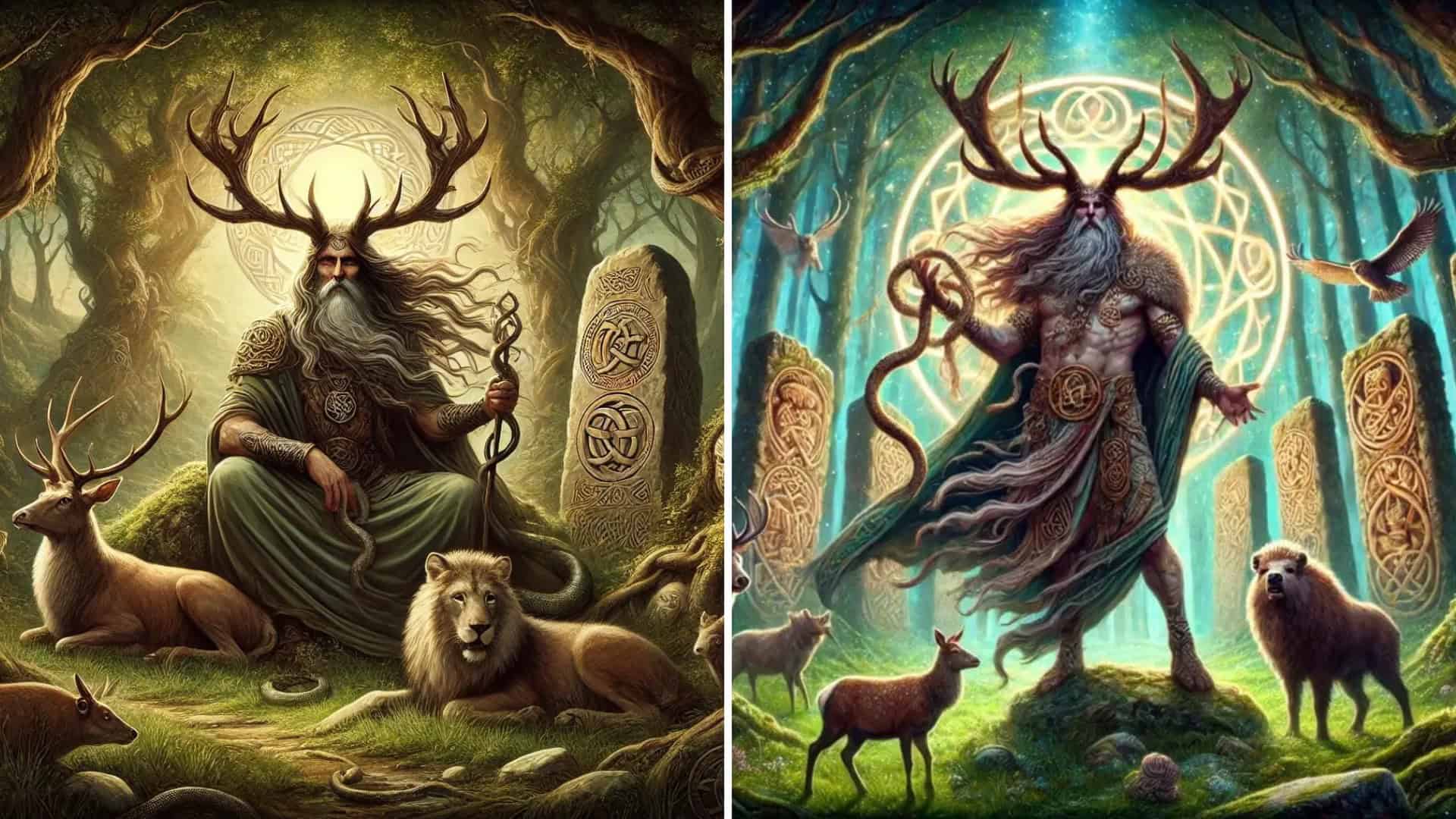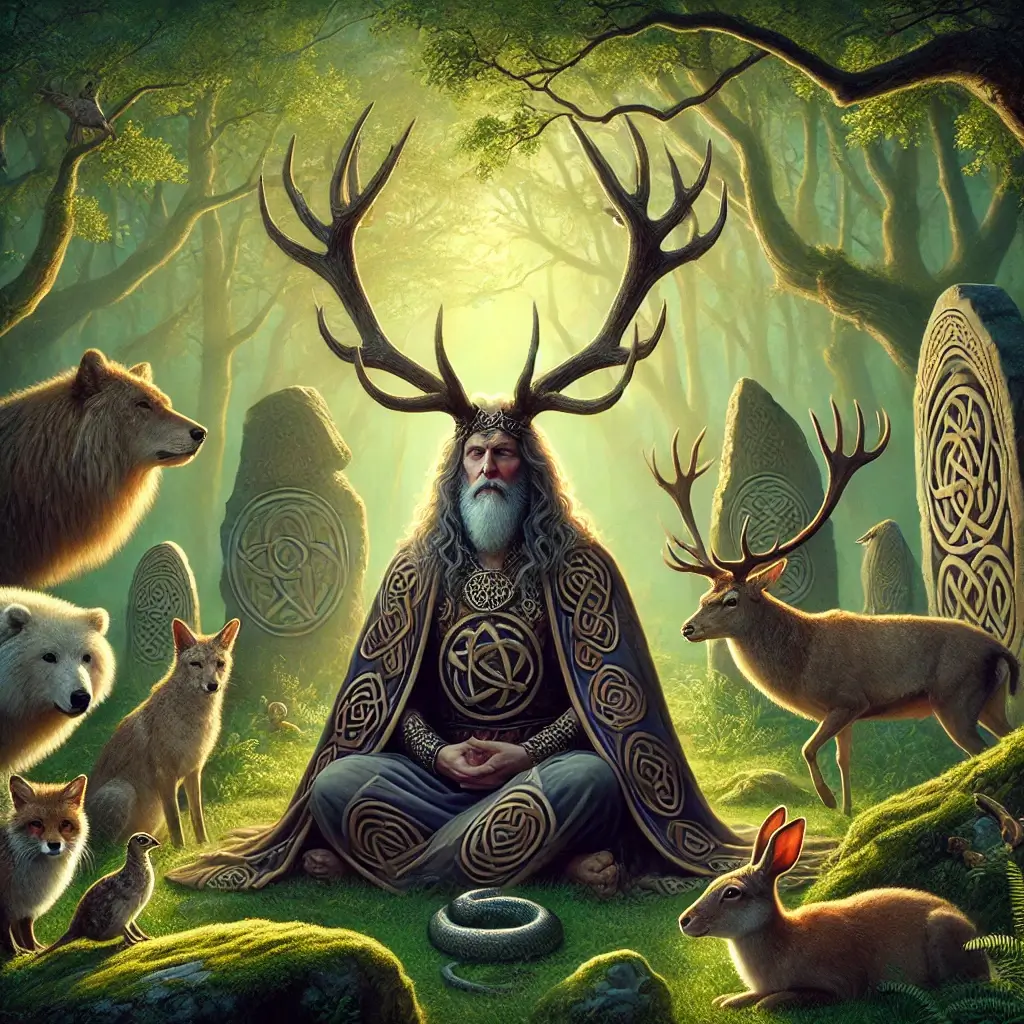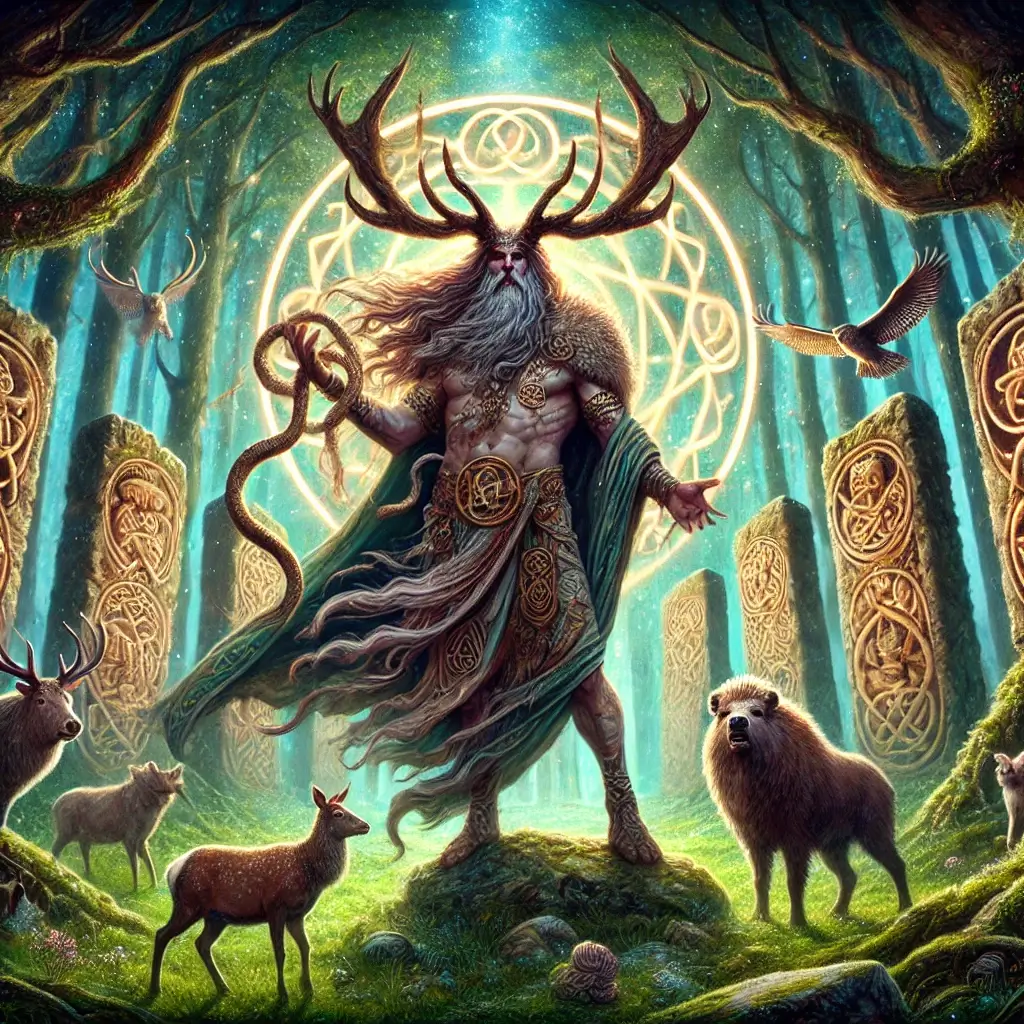No products in the cart.

Cernunnos, often depicted as the horned god, is one of the most intriguing and enigmatic deities in Celtic mythology. Associated with animals, fertility, nature, and the forest, he embodies the cycles of life, death, and rebirth. His image, often depicted with antlers or horns, reflects his role as a mediator between humans, animals, and the natural world.
While Cernunnos is primarily linked to Gaulish traditions, his influence and symbols resonate deeply in Irish and broader Celtic mythology, making him a central figure in pagan spirituality and rituals like Beltane.

Cernunnos, whose name derives from the Proto-Celtic root karno- meaning “horn” or “antler,” is the quintessential god of nature and fertility. Although references to Cernunnos by name are sparse in surviving Celtic texts, his imagery is widespread across ancient artifacts and inscriptions, particularly in Gaul, Britain, and Ireland.
His antlers or horns connect him to stag symbolism, representing virility, abundance, and the untamed wilderness. Often depicted seated in a meditative posture, surrounded by animals such as deer, serpents, bulls, and wolves, he reflects a deep connection to the natural world. In Celtic belief, these animals were seen as sacred, each symbolizing aspects of the life force he governed.
Cernunnos appears as a unifying figure in Celtic mythology, often embodying dualities such as life and death, man and animal, and nature and the spiritual realm. His role as a protector of the forest and a deity of the underworld bridges the physical and metaphysical worlds. In some interpretations, he presides over the Otherworld, ensuring the fertility of both the land and its inhabitants.
Despite his association with Gaul, evidence of Cernunnos Irish god motifs exists in ancient Irish artifacts. The Gundestrup Cauldron, a silver vessel discovered in Denmark, depicts a horned figure resembling Cernunnos surrounded by animals, possibly signifying his universality in Celtic belief systems.

Cernunnos plays a central role in Beltane, the ancient Celtic festival celebrating fertility, life, and the renewal of abundance in spring. Held on May 1st, Beltane marks the transition from winter’s dormancy to summer’s vibrant growth. In Celtic mythology, Cernunnos is often viewed as the consort of a Spring Goddess, representing the fertile union that rejuvenates the earth. Together, they embody the cycles of nature, where Cernunnos’ untamed energy fertilizes the land, and the Spring Goddess nurtures it into abundance.
This partnership reflects the sacred marriage between masculine and feminine energies, a recurring theme in Celtic spirituality. The Spring Goddess symbolizes the earth’s receptivity and fertility, while Cernunnos personifies vitality, passion, and wild creativity. Their union ensures the land’s prosperity, reinforcing the harmony between humanity and nature. This divine connection is central to Beltane rituals, which celebrate the earth’s fertility and the life force animating it.
During Beltane, bonfires are lit to invoke the warmth and energy of the sun. People leap over the flames for protection, fertility, and good fortune. Dances around the Maypole, a symbol of fertility and unity, mimic the intertwining energies of Cernunnos and the Spring Goddess. Offerings of food, flowers, and symbolic gifts are made to honour their blessings.
Cernunnos’ role in Beltane highlights his position as a god of fertility and life, uniting with the Spring Goddess to awaken the earth, ensuring growth, vitality, and the interconnected cycles of nature and life.

The various symbols associated with Cernunnos reflect his multifaceted role in Celtic mythology:
Cernunnos’ antlers are his most recognizable symbol, often depicted as stag-like and sprawling. These antlers reflect his deep connection to the animal kingdom, representing strength, virility, and his role as a guardian of the forest. Stags, considered noble creatures in Celtic culture, symbolized fertility and renewal, perfectly aligning with Cernunnos’ dominion over nature. Stag antlers also embody the cyclical nature of life, shedding and regrowing each year, mirroring the themes of death and rebirth central to Celtic spirituality. Through his antlers, Cernunnos becomes a bridge between the mortal world and the wild, embodying balance and harmony with nature.
The serpent with horns is a recurring companion in depictions of Cernunnos, symbolizing renewal, fertility, and transformation. Snakes were revered in Celtic belief for their ability to shed their skin, signifying rebirth and the cycle of life. The horns elevate the serpent’s spiritual significance, connecting it to the divine realm and the god’s power over both the natural and supernatural worlds. The serpent also ties Cernunnos to the underworld, often viewed as a place of hidden knowledge and fertile potential. Together, the serpent and Cernunnos represent life’s constant evolution and the interconnectedness of all living beings.
The torcs depicted with Cernunnos—often worn around his neck or held in his hands—are symbols of wealth, status, and divine authority. In Celtic culture, torcs were highly valued ornaments worn by chieftains, warriors, and deities, signifying their power and connection to the spiritual world. Cernunnos’ association with torcs highlights his role as a provider of abundance and a giver of prosperity. By holding multiple torcs, he embodies the act of bestowing blessings upon both the natural and human worlds. This imagery ties Cernunnos to material wealth and the spiritual richness that stems from living in harmony with nature.
Cernunnos’ close relationship with animals illustrates his role as a guardian of the wild and a protector of all living creatures. His depictions often include animals like stags, bulls, wolves, and boars, each with its own significance. Stags symbolize renewal and the wild’s majesty, while bulls represent strength, fertility, and abundance. Wolves embody guardianship and communal bonds, while boars signify courage and provision. Through these animals, Cernunnos is shown as both a nurturer of life and a manifestation of nature’s raw power. His connection to animals underscores his role as the mediator between humanity and the wilderness.
The Green Man is a figure closely tied to Cernunnos, symbolizing the cyclical nature of vegetation and the constant renewal of life in the natural world. Often depicted as a face surrounded by leaves or foliage, the Green Man represents life’s eternal cycles: growth, decay, and rebirth. Though Cernunnos is more directly associated with animals, his link to the Green Man highlights his influence over fertility, the seasons, and the earth’s abundance. Together, they reflect the interconnectedness of all natural forces, making Cernunnos not just a protector of the wild but a divine overseer of life itself.

Cernunnos, the Celtic horned god, is intricately linked to several goddesses, representing the balance of nature’s masculine and feminine forces. His associations highlight themes of fertility, renewal, and the interconnected cycles of life. These divine relationships emphasize his role as both a protector of the natural world and a partner in the sacred union that sustains creation.
The Green Lady, sometimes seen as Cernunnos’ consort, is a figure tied to the lushness of summer and the fecundity of the earth. She represents the flourishing of crops, the abundance of nature, and the nurturing aspects of the land. Cernunnos and the Green Lady together symbolize the balance between protection and growth, wildness and cultivation.
This relationship reflects the duality of nature’s forces, where the untamed energy of Cernunnos complements the nurturing and grounding power of the Green Lady.
Some scholars propose that the image of Cernunnos as a horned god may have evolved from an earlier Deer Goddess. In prehistoric and early Celtic traditions, the deer was a sacred animal often linked to fertility and the mysteries of life. Cernunnos’ antlers and his deep connection to the natural world may preserve echoes of this earlier feminine archetype.
This duality—a masculine god derived from feminine origins—demonstrates the Celts’ understanding of nature’s fluidity and their reverence for both aspects of the divine.
Cernunnos’ associations with these goddesses underscore his role as a figure of harmony and balance in Celtic mythology. Through these partnerships, he becomes more than a protector of the forest; he embodies the sacred unity that ensures the cycles of life, death, and renewal continue to flourish.

The association between Cernunnos and the Green Man ties him to the spirit of the forest. Both figures symbolize the life force within nature and the sacred connection humans share with the wilderness. In this role, Cernunnos Green Man embodies the god of the forest, overseeing the balance of the ecosystem and the fertility of the land.
His connection to the underworld further deepens this symbolism. In Celtic belief, the underworld was not a place of punishment but a realm of renewal, where life and death coexisted. As the god of the underworld, Cernunnos guided souls through these transitions, ensuring the balance of natural cycles.
In modern pagan practices, Cernunnos pagan god is revered as a guardian of the earth and a symbol of environmental balance. His image inspires reverence for nature and a commitment to ecological harmony. He is often invoked in rituals celebrating fertility, protection, and the interconnectedness of life. Sometimes Cernunnos is portrayed as God of the Underworld.
Cernunnos, the Celtic horned god, remains one of the most enduring symbols of nature, fertility, and the sacred bond between humanity and the earth. From his ancient depictions on the Gundestrup Cauldron to his role in modern pagan rituals, Cernunnos embodies the timeless cycles of life and the harmony of the natural world. His stories, symbols, and rituals continue to inspire a deep connection to the wilderness, making him a powerful and compelling figure in Celtic mythology.
















